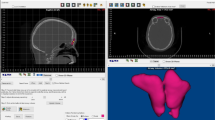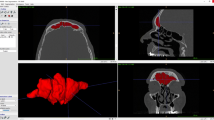Abstract
Forensic identification of human remains is crucial for legal, humanitarian, and civil reasons. Wide heterogeneity in sphenoid sinus morphology can be used for personal identification. This study aimed to propose a new protocol for personal identification based on three-dimensional (3D) reconstruction of sphenoid sinus CT images using Iterative Closest Point (ICP) algorithm. Seven hundred thirty-two patients which consisted of 348 females and 384 males were retrospectively included. The study sample includes 732 previous images as a source point set and 743 later ones as a scene target set. The sphenoid sinus computed tomography (CT) images were processed on a workstation (Dolphin imaging) to obtain 3D images and stored as a file format of Stereo lithography (.STL). Then, a Python library vtkplotter was used to transform the STL format to PLY format, which was adapted to Point Cloud Library (PCL). The ICP algorithm was used for point clouds matching. The metric Rank-N recognition rate was used for evaluation. The scene target set of 743 individuals was compared with the source point set of 732 individual models and achieved Rank-1 accuracy of 96.24%, Rank-2 accuracy of 99.73%, and Rank-3 accuracy of 100%. Our results indicated that the 3D point cloud registration of sphenoid sinuses was useful for assessing personal identification in forensic contexts.






source point set and scene target set
Similar content being viewed by others
Availability of Data and Material
The data and material that support the findings of this study are available from the corresponding author upon reasonable request.
Code Availability
Not applicable.
References
Ciaffi R, Gibelli D, and Cattaneo C, Forensic radiology and personal identification of unidentified bodies: a review, Radiol Med 116(6), 960-8, 2011.
Souza LA, Jr., Marana AN, and Weber SAT, Automatic frontal sinus recognition in computed tomography images for person identification, Forensic Sci Int 286, 252-264, 2018.
Deloire L, Diallo I, Cadieu R, Auffret M, Alavi Z, Ognard J, and Ben Salem D, Post-mortem X-ray computed tomography (PMCT) identification using ante-mortem CT-scan of the sphenoid sinus, J Neuroradiol 46(4), 248-255, 2019.
Guldner C, Pistorius SM, Diogo I, Bien S, Sesterhenn A, and Werner JA, Analysis of pneumatization and neurovascular structures of the sphenoid sinus using cone-beam tomography (CBT), Acta Radiol 53(2), 214-9, 2012.
Laury AM, Oyesiku NM, Hadjipanayis CG, Delgaudio JM, and Wise SK, Incidental sinonasal findings identified during preoperative evaluation for endoscopic transsphenoidal approaches, Am J Rhinol Allergy 27(3), 202-5, 2013.
Chaiyasate S, Baron I, and Clement P, Analysis of paranasal sinus development and anatomical variations: a CT genetic study in twins, Clin Otolaryngol 32(2), 93-7, 2007.
Souadih K, Belaid A, Ben Salem D, and Conze PH, Automatic forensic identification using 3D sphenoid sinus segmentation and deep characterization, Med Biol Eng Comput 58(2), 291-306, 2020.
Cappella A, Gibelli D, Cellina M, Mazzarelli D, Oliva AG, De Angelis D, Sforza C, and Cattaneo C, Three-dimensional analysis of sphenoid sinus uniqueness for assessing personal identification: a novel method based on 3D-3D superimposition, Int J Legal Med 133(6), 1895-1901, 2019.
Ruder TD, Kraehenbuehl M, Gotsmy WF, Mathier S, Ebert LC, Thali MJ, and Hatch GM, Radiologic identification of disaster victims: a simple and reliable method using CT of the paranasal sinuses, Eur J Radiol 81(2), e132-8, 2012.
Gibelli D, Cellina M, Cappella A, Gibelli S, Panzeri MM, Oliva AG, Termine G, De Angelis D, Cattaneo C, and Sforza C, An innovative 3D-3D superimposition for assessing anatomical uniqueness of frontal sinuses through segmentation on CT scans, Int J Legal Med 133(4), 1159-1165, 2019.
Auffret M, Garetier M, Diallo I, Aho S, and Ben Salem D, Contribution of the computed tomography of the anatomical aspects of the sphenoid sinuses to forensic identification, J Neuroradiol 43(6), 404-414, 2016.
Mou Q-n, Ji L-l, Liu Y, Zhou P-r, Han M-q, Zhao J-m, Cui W-t, Chen T, Du S-y, Hou Y-x, and Guo Y-c, Three-dimensional superimposition of digital models for individual identification, Forensic Sci Int 318, 110597, 2021.
Yang L and Chakraborty R, "A GMM Based Algorithm To Generate Point-Cloud And Its Application To Neuroimaging," in 2020 IEEE 17th International Symposium on Biomedical Imaging Workshops (ISBI Workshops), 2020, pp. 1–4.
He Y, Liang B, Yang J, Li S, and He J, An Iterative Closest Points Algorithm for Registration of 3D Laser Scanner Point Clouds with Geometric Features, Sensors (Basel) 17(8), 1862, 2017.
Reino AJ, Factors in the pathogenesis of tumors of the sphenoid and maxillary sinuses: a comparative study, Laryngoscope 110(10 Pt 2 Suppl 96), 1–38, 2000.
Uthman AT, Al-Rawi NH, Al-Naaimi AS, Tawfeeq AS, and Suhail EH, Evaluation of frontal sinus and skull measurements using spiral CT scanning: an aid in unknown person identification, Forensic Sci Int 197(1–3), 124 e1–7, 2010.
Kawarai Y, Fukushima K, Ogawa T, Nishizaki K, Gunduz M, Fujimoto M, and Masuda Y, Volume quantification of healthy paranasal cavity by three-dimensional CT imaging, Acta Otolaryngol Suppl 540, 45-9, 1999.
Zhu H, Guo B, Zou K, Li Y, Yuen KV, Mihaylova L, and Leung H, A Review of Point Set Registration: From Pairwise Registration to Groupwise Registration, Sensors (Basel) 19(5)2019.
Besl PJ and McKay ND, A method for registration of 3-D shapes, IEEE Transactions on Pattern Analysis and Machine Intelligence 14(2), 239-256, 1992.
Author information
Authors and Affiliations
Corresponding authors
Ethics declarations
Ethics Approval
The present study was a retrospective study with approval by the Ethics Committee of Sichuan University and a waiver of the requirement for informed consent was obtained.
Consent to Participate
Not applicable.
Consent for Publication
Not applicable.
Conflict of Interest
The authors declare no competing interests.
Additional information
Publisher's Note
Springer Nature remains neutral with regard to jurisdictional claims in published maps and institutional affiliations.
Xiaoai Dong and Fei Fan contributed equally to this work.
Rights and permissions
About this article
Cite this article
Dong, X., Fan, F., Wu, W. et al. Forensic Identification from Three-Dimensional Sphenoid Sinus Images Using the Iterative Closest Point Algorithm. J Digit Imaging 35, 1034–1040 (2022). https://doi.org/10.1007/s10278-021-00572-w
Received:
Revised:
Accepted:
Published:
Issue Date:
DOI: https://doi.org/10.1007/s10278-021-00572-w




